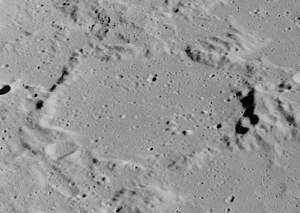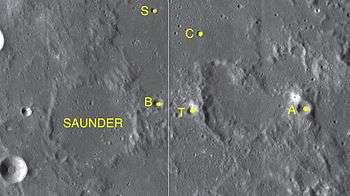Saunder (crater)
 Lunar Orbiter 4 image | |
| Coordinates | 4°12′S 8°48′E / 4.2°S 8.8°ECoordinates: 4°12′S 8°48′E / 4.2°S 8.8°E |
|---|---|
| Diameter | 45 km (28 mi) |
| Depth | 1.3 km (0.81 mi) |
| Colongitude | 352° at sunrise |
| Eponym | Samuel A. Saunder |

Saunder is a lunar impact crater located in the central highland region of the Moon, to the east-northeast of the walled plain Hipparchus, named after Samuel Arthur Saunder. The outer wall is irregular and broken in several locations, forming the overall shape of a pentagon. The interior of Saunder has been flooded with lava, forming a level surface just below the rim. The floor lacks a central peak, but there are low rises in the southeast quadrant and a tiny craterlet towards the north rim.
One other crater, smaller is about 35 km nearly to the northwest and is Pickering, also around 55 km north-northeast is the larger Lade and about 120 km southeast is Lindsay.
Its diameter is 45 km long and is 1,300 meters deep, also, the area is around 1,200 km².
Satellite craters
By convention these features are identified on lunar maps by placing the letter on the side of the crater midpoint that is closest to Saunder. Saunder A is located far east close to Theon Senior Crater, Saunder B is east-northeast next to the main crater, Saunder C is to the northeast, Saunder C is to the east-north east and Saunder T is to the east.

| Saunder | Latitude | Longitude | Diameter |
|---|---|---|---|
| A | 4.0° S | 12.3° E | 8 km (5.0 mi) |
| B | 3.9° S | 9.8° E | 6 km (3.7 mi) |
| C | 2.7° S | 10.5° E | 4 km (2.5 mi) |
| S | 2.3° S | 9.7° E | 4 km (2.5 mi) |
| T | 4.0° S | 10.4° E | 6 km (3.7 mi) |
References
- Andersson, L. E.; Whitaker, E. A. (1982). NASA Catalogue of Lunar Nomenclature. NASA RP-1097.
- Blue, Jennifer (July 25, 2007). "Gazetteer of Planetary Nomenclature". USGS. Retrieved 2007-08-05.
- Bussey, B.; Spudis, P. (2004). The Clementine Atlas of the Moon. New York: Cambridge University Press. ISBN 978-0-521-81528-4.
- Cocks, Elijah E.; Cocks, Josiah C. (1995). Who's Who on the Moon: A Biographical Dictionary of Lunar Nomenclature. Tudor Publishers. ISBN 978-0-936389-27-1.
- McDowell, Jonathan (July 15, 2007). "Lunar Nomenclature". Jonathan's Space Report. Retrieved 2007-10-24.
- Menzel, D. H.; Minnaert, M.; Levin, B.; Dollfus, A.; Bell, B. (1971). "Report on Lunar Nomenclature by the Working Group of Commission 17 of the IAU". Space Science Reviews. 12 (2): 136–186. Bibcode:1971SSRv...12..136M. doi:10.1007/BF00171763.
- Moore, Patrick (2001). On the Moon. Sterling Publishing Co. ISBN 978-0-304-35469-6.
- Price, Fred W. (1988). The Moon Observer's Handbook. Cambridge University Press. ISBN 978-0-521-33500-3.
- Rükl, Antonín (1990). Atlas of the Moon. Kalmbach Books. ISBN 978-0-913135-17-4.
- Webb, Rev. T. W. (1962). Celestial Objects for Common Telescopes (6th revised ed.). Dover. ISBN 978-0-486-20917-3.
- Whitaker, Ewen A. (1999). Mapping and Naming the Moon. Cambridge University Press. ISBN 978-0-521-62248-6.
- Wlasuk, Peter T. (2000). Observing the Moon. Springer. ISBN 978-1-85233-193-1.
External links
| Wikimedia Commons has media related to Saunder (crater). |